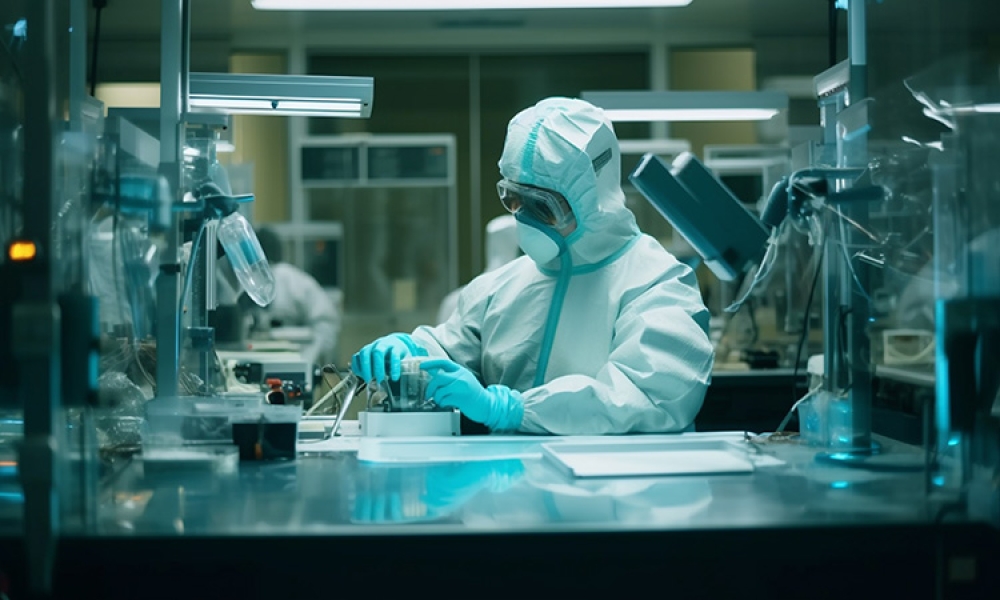Case Study: Impact of Closed Aseptic Processing on Facility

What are the potential cost savings when moving closer to a closed Aseptic process? What are the advantages and disadvantages of implementing this process? What architectural layout is best for my facility? JacobsWyper Architects prepared a case study with a global pharmaceutical company to consider possible impacts or changes within a pharmaceutical manufacturing facility specifically related to aseptic filling design. We explored spatial, functional, and financial implications and compared 4 different types of aseptic processing:
- Traditional
- RABS
- Isolation
- Robotic Isolation
We studied the differences between four hypothetical architectural layouts based on processing types with applied material & personnel flows, classification levels, new construction costs, square footage, and operational costs. Advantages and disadvantages of Aseptic processing types: Traditional Advantage:
- Risk in changing an existing process
Traditional Disadvantages:
- Operating at high risk
- Large amount of Grade A space
- Increased operational costs
RABS Advantages:
- Easy to install and validate
- Inexpensive
- Able to downgrade production area to Grade B
RABS Disadvantages:
- Surrounding production area must be Grade B
- No operator protection
- No possibility to recycle air inside
- No possibility to perform WIP cycles or auto-decontamination cycles
Isolation Advantages:
- Highest product protection
- Able to downgrade production area to Grade C
- Air inside Isolator can be recycled – HVAC energy consumption savings
- Possible to perform WIP cycles or automatic decontamination cycles
- Enhanced automation/cost savings
Isolation Disadvantages:
- Cannot be installed on existing machines
- Higher purchase cost
Robotic Isolation Advantages:
- Flexible
- Faster equipment production – approximately 7 months (18 months typical Isolator)
- Smaller footprint
- Less equipment to test and validate
- Quick changeover (1 hour)
- Utility savings – no washing/oven
- Operator reduction and cost savings
Robotic Isolation Disadvantages:
- Small-scale solution
- Slower production
We found interesting results analyzing the square footage differences between the layouts of each process and what that would indicate from a cost per/sf. The cost per/sf. metric used was taken from market costs in September of 2016. They were as follows:
- Grade A: $2,655/sf.
- Grade B: $840/sf.
- Grade C: 495/sf.
- Grade D: $415/sf.
These numbers excluded utility & equipment costs but did include commissioning and validation. Major Differences in Processing Types:
- Major square footage impact of moving from a Traditional to RABS process, is the transfer of a large amount of Grade A space to Grade B. We estimated that this shift would indicate a $225 /sf. cost savings.
- Major difference when shifting from RABS to an isolator is in the reduction of Grade B space turned to Grade C space. This cost savings per sq. was estimated at $156 /sf.
- Finally, the shift between the isolator to a robotic isolator causes a dramatic drop in Grade D space due to applying single-use (pre-sterilized components) and removing built in sterilization equipment.
- Decontamination would also occur within the robotic isolator. This estimated cost savings adjusted to $71/sf. and an overall square footage reduction to the process of 2,370 sf. This space could be given back to the facility for other opportunities.
To take this case study one step further, we quantified other cost metrics with a major pharmaceutical company that had gone through a similar renovation project. We extrapolated these cost metrics and applied them to our four process designs to investigate the potential outcome. These cost metrics included reduction of gowning supplies, labor and gowning time/material transfer, cleaning supplies and labor costs based on classification level, and environmental testing. Removal of (1) Pal/Mal = $13.50 /transaction or approximately $136,000/yr. Outcomes:
- In labor, gowning time and material transfer for removal of (1) Pal/Mal = $130,000/yr. or $40.63/hr. or 3,200 hours/yr.
- Cleaning supplies and labor from downgrading to a Grade B from a Grade C = $75,000 / yr. for 3,100/sf., or approx. $24.20/hr.
- Lastly environmental testing metric from downgrading from an (A/B) space to a Grade C space; this equates to the removal of 2,420 sf. of (A/B) which is approx. 2,800 tests, or $530,000/ yr., or $190/test, or $219/sf.
For example, based on the metrics above, our findings indicate savings when moving from RABS to an isolator the savings could be approximately $2m dollars per year, plus a reduction in air handling costs by 45%. Looking forward, items we see as issues or drivers to discuss the possibility of moving toward a closed aseptic processing are:
- Risk assessment on an existing process and facility could offer directional value
- Substantial cost saving advantage with automation
- Isolation allows for no product exposure
- Greater personnel protection from product
- Potential labor reduction
- Possible reduction to production square footage allowing space for other assets
- Risk reduction
2017 Aseptic Processing Conference: The ISPE Aseptic Conference provides a unique forum for attendees and speakers from industry, academia, and regulatory offices to exchange ideas and solutions addressing the growing complexities in the field of aseptic processing. The ISPE Aseptic Conference has established itself as the pharmaceutical industry's premier source to stay in-the-know about the latest trends in aseptic and barrier operations. This signature event will summarize innovative technology and best practices successfully employed to meet the growing complexities for aseptic processing without losing focus on classic aseptic and barrier applications.



